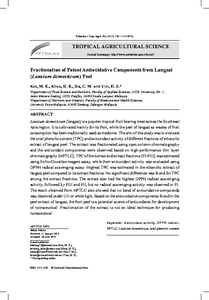Citation
Kee, M. E. and Khoo, Hock Eng and Sia , Chiaw Mei and Yim, Hip Seng
(2015)
Fractionation of potent antioxidative components from langsat
(Lansium domesticum) peel.
Pertanika Journal of Tropical Agricultural Science, 38 (1).
pp. 103-112.
ISSN 1511-3701; ESSN: 2231-8542
Abstract
Lansium domesticum (langsat) is a popular tropical fruit bearing trees across the Southeast Asia region. It is cultivated mainly for its fruit, while the peel of langsat as wastes of fruit consumption has been traditionally used as medicine. The aim of this study was to evaluate the total phenolic content (TPC) and antioxidant activity of different fractions of ethanolic extract of langsat peel. The extract was fractionated using open column chromatography and the antioxidant components were observed based on high-performance thin layer chromatography (HPTLC). TPC of the extract and extract fractions (FI˗FIII) was estimated using Folin-Ciocalteu reagent assay, while their antioxidant activity was evaluated using DPPH radical scavenging assay. Highest TPC was estimated in the ethanolic extract of langsat peel compared to its extract fractions. No significant difference was found for TPC among the extract fractions. The extract also had the highest DPPH radical scavenging activity, followed by FIII and FII, but no radical scavenging activity was observed in FI. The result obtained from HPTLC also showed that no band of antioxidative compounds was observed under UV or white light. Based on the antioxidative components found in the peel extract of langsat, the fruit peel is a potential source of antioxidants for development of nutraceutical. Fractionation of the extract is not an ideal technique for producing nutraceutical.
Download File
![[img]](http://psasir.upm.edu.my/41825/1.hassmallThumbnailVersion/Fractionation%20of%20potent%20antioxidative%20components%20from%20langsat%20%28Lansium%20domesticum%29%20peel.pdf)  Preview |
|
PDF
Fractionation of potent antioxidative components from langsat (Lansium domesticum) peel.pdf
Download (584kB)
| Preview
|
|
Additional Metadata
Actions (login required)
 |
View Item |

